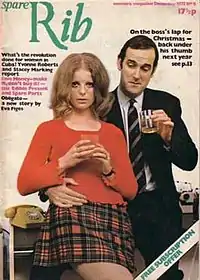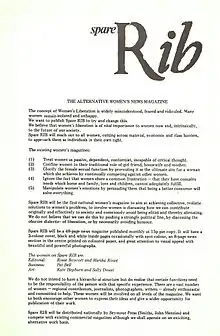Spare Rib
Spare Rib was a second-wave feminist magazine in the United Kingdom that emerged from the counter culture of the late 1960s as a consequence of meetings involving, among others, Rosie Boycott and Marsha Rowe. Spare Rib is now recognised as an iconic magazine, which shaped debate about feminism in the UK, and as such it was digitised by the British Library in 2015.[1] The magazine contained new writing and creative contributions which challenged stereotypes and supported collective solutions. It was published between 1972 and 1993.[2] The title derives from the Biblical reference to Eve, the first woman, created from Adam's rib.
 Spare Rib cover, December 1972; featuring John Cleese on the cover. | |
| Editor | Collective from late 1973 |
|---|---|
| Categories | Feminist Magazine |
| Year founded | 1972 |
| Final issue | 1993 |
| Country | United Kingdom |
| Language | English |
| Website | http://www.bl.uk/spare-rib (archive) |
History
Spare Rib's first issue was published in June 1972.[3] At the time, some newsagents refused to stock it, including W. H. Smith. Selling at first around 20,000 copies per month, it was circulated more widely through women's groups and networks.
Its purpose, as described in its editorial, was to investigate and present alternatives to the traditional gender roles for women of virgin, wife or mother.[4]
The name Spare Rib started as a joke, with its play on words about the Biblical Eve fashioned out of Adam’s rib, implying that a woman had no independence from the beginning of time. This held the witty, subversive connotations the editors had been looking for.[5]
The Spare Rib Manifesto stated:
"The concept of Women’s Liberation is widely misunderstood, feared and ridiculed. Many women remain isolated and unhappy. We want to publish Spare RIB to try to change this. We believe that women’s liberation is of vital importance to women now and, intrinsically, to the future of our society. Spare RIB will reach out to all women, cutting across material, economic and class barriers, to approach them as individuals in their own right".[6]
Early articles were linked closely with left-leaning political theories of the time, especially anti-capitalism and the exploitation of women as consumers through fashion. The covers were often of a striking design.[7]
As the women's movement evolved during the 1970s, the magazine became a focus for sometimes acrimonious debate between the many streams that emerged within the movement, such as socialist feminism, radical feminism, revolutionary feminism, lesbian feminism, liberal feminism and black feminism.[8] It included contributors from well-known international feminist writers, activists and theorists as well as the stories of ordinary women in their own words.
Spare Rib articles tackled many different threads of feminism from many different angles. Subjects included: “liberating orgasm”, “kitchen sink racism”, anorexia and the practice of female genital mutilation. The ensuing debates were often acrimonious, and the magazine reflected the sometimes turbulent debates within the collective on how best to tackle issues such as sexuality and racism.[9]
Suffering from the effects of falling subscriptions and advertising revenue Spare Rib ceased publication in 1993.[3][10]
Editors

Spare Rib became a collective by the end of 1973 (see Spare Rib Reader, edited by Marsha Rowe, and Rosie Boycott, A Nice Girl Like Me). The collective editorial policy was to: "collectively decide on articles that they publish, and work closely with the contributors. Accept articles from men only when there is no other resource available. 35p per copy."[3]
Design
According to Marsha Rowe, one of the original magazine designers, the "look" of Spare Rib, which resulted in so many iconic and striking covers, was born out of necessity. It had to look like a women’s magazine, yet with contents that did not reflect the conformist stereotyping of women. Spare Rib covers were often controversial. It had to suggest the familiarity of women’s magazines – 'like a good friend, intimate, loyal, supportive – while also being challenging, questioning, exciting and radical'.[5] The designers had to transform the name Spare Rib into a magazine title. They had to create the front cover look, and an overall style for the pages inside the magazine. The design had to be both stable and flexible, to allow for future change while retaining the feel and basic identity. Integral to every decision was cost. "Money and professionalism went hand in hand."[5]
New, young illustrators and photographers were keen to work for the magazine, enjoying the challenge of finding a visual language to express the new ideas of the magazine.
Finding non-sexist advertising in accordance with the values of the magazine was another challenge.
Legacy
It was reported by The Guardian in April 2013 that the magazine was due to be relaunched, with the journalist Charlotte Raven at the helm.[11] It was subsequently announced that while a magazine and website were to be launched, it would now have a different name.[12][13]
In May 2015, the British Library put its complete archive of Spare Rib online.[9] The project was led by Polly Russell, the curator behind an oral history of the women's liberation movement.[14] The archive is presented with new views on the subject matter and themes curated by expert commentators. The British Library website describes the value of Spare Rib for current readers and researchers:
"Spare Rib was the largest feminist circulating magazine of the Women’s Liberation Movement (WLM) in Britain of the 1970s and 80s. It remains one of the movement’s most visible achievements. The trajectory of Spare Rib charted the rise and demise of the Women’s Liberation Movement and as a consequence is of interest to feminist historians, academics and activists and to those studying social movements and media history".[15]
In February 2019 the British Library announced a possible suspension of access to the archive in the event of a no-deal Brexit.[16][17]
References
- "About the Spare Rib Digitisation Project". The British Library. Retrieved 4 April 2018.
- "A short history of the most radical DIY magazines". Dazed. Retrieved 5 October 2016.
- "Spare Rib (Magazine, 1972-1993)". Grassroots Feminism. 7 August 2009. Retrieved 10 August 2015.
- "Women’s History Month: Spare Rib", Women's History Network, 22 March 2011.
- "The design of Spare Rib". Creative Review. Retrieved 8 March 2016.
- "Facsimile of Spare Rib manifesto". The British Library. Retrieved 8 March 2016.
- "The Best of Spare Rib". Stylist Magazine. Retrieved 8 March 2016.
- O'Sullivan, Sue. "Feminists and Flourbombs". Channel 4. Archived from the original on 16 September 2008.
- Spare Rib goes digital: 21 years of radical feminist magazine put online The Guardian. 28 May 2015. Retrieved 10 August 2015.
- Elke Zobl; Ricarda Drüeke (March 2014). Feminist Media: Participatory Spaces, Networks and Cultural Citizenship. Transcript Verlag. p. 56. ISBN 978-3-8394-2157-4. Retrieved 27 October 2015.
- Ben Dowell, "Spare Rib magazine to be relaunched by Charlotte Raven", The Guardian, 25 April 2013.
- Charlotte Raven, "My 'wounding' battle with Spare Rib founders over feminism 2.0", The Telegraph, 24 June 2013.
- "'Spare Rib' founders threaten legal action over magazine relaunch". The Independent. Retrieved 8 March 2016.
- "Women's Liberation Movement". The British Library. Retrieved 4 April 2018.
Join Polly Russell, Lead Curator for Contemporary Archives and Manuscripts, for a discussion on feminism. Polly was the British Library lead on Sisterhood and After, a project and website to create the UK’s first ever oral history archive of the Women’s Liberation Movement. Polly was also the lead for a project which digitised and made freely available the feminist magazine Spare Rib.
- "About the Spare Rib Digitisation Project". The British Library. Retrieved 8 March 2016.
- "Possible Suspension of Access". The British Library. Retrieved 19 February 2019.
- O'Carroll, Lisa (25 February 2019). "Spare Rib digital archive faces closure in event of no-deal Brexit". The Guardian.
Sources
- An extensive collection of most if not all publications can be found in the Women's Library reference/reading room in London.
- Feminist Publications Brief history of Spare Rib at Bristol University History Department. Retrieved June 2008.
- Interview with Marsha Rowe The first editor of feminist magazine Spare Rib interviewed by Claire Daly at The F-Word. 31 January 2008. Retrieved June 2008.
- O'Sullivan, Sue. "Feminists and Flourbombs". Channel 4. Archived from the original on 16 September 2008. Written by 1979–1984 editor of Spare Rib.
- Article on Spare Rib by Hazel K. Bell from The National Housewives Register's Newsletter no. 19, Autumn 1975, pp. 10–11. Retrieved June 2008.
- Steiner, Linda; Chambers, Deborah; Fleming, Carole (2004). "Women's alternative media in broadcasting and the Internet". In Steiner, Linda; Chambers, Deborah; Fleming, Carole (eds.). Women and journalism. London New York: Routledge. p. 166. ISBN 9780203500668. Preview.
Further reading
- Fell, Alison (1979). Hard Feelings: Fiction and Poetry from Spare Rib. London: Women's Press Ltd. ISBN 9780704338388.
- Rowe, Marsha (1982). Spare Rib Reader. Harmondsworth, Middlesex, England New York, NY, U.S.A: Penguin Books. ISBN 9780140052503.
- Boycott, Rosie (2009) [1984]. A Nice Girl Like Me. London: Pocket Books. ISBN 9781847394705.
- O'Sullivan, Sue (1987). Women's Health: A Spare Rib Reader. London New York: Pandora Press. ISBN 9780863582189.
- Cameron, Deborah; Scanlon, Joan (2010). The Trouble & Strife Reader. London New York: Bloomsbury Academic. ISBN 9781849660129. Documenting the history of the British magazine Trouble and Strife: The Radical Feminist Magazine, which ran from 1983 to 2002.
External links
- British Library archive
- Full, free-to-access, online archive hosted by the JISC Journal Archive
- Marsha Rowe, Rosie Boycott, Angela Phillips, Marion Fudger and Anna Raeburn talk to Sue MacGregor about the early years, BBC Radio 4.
- Photo of Marsha Rowe and Rosie Boycott Founders of Spare Rib, at the magazine's offices, 19 June 1972.
